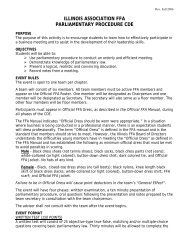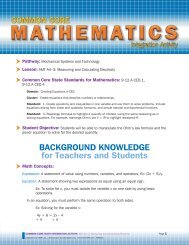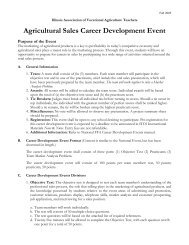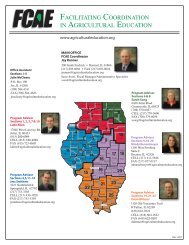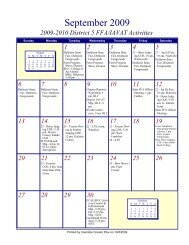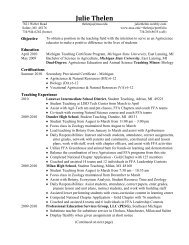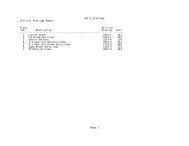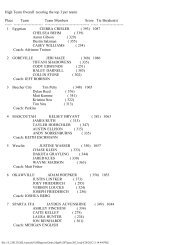Agriculture Mechanics A3-5 Planning and Placing Concrete - Illinois ...
Agriculture Mechanics A3-5 Planning and Placing Concrete - Illinois ...
Agriculture Mechanics A3-5 Planning and Placing Concrete - Illinois ...
You also want an ePaper? Increase the reach of your titles
YUMPU automatically turns print PDFs into web optimized ePapers that Google loves.
<strong>Agriculture</strong> Concepts:Volumes are used frequently in agricultural construction <strong>and</strong> production, especially whendetermining the amount of concrete needed for a particular job. Ordering too muchconcrete costs extra money, <strong>and</strong> the excess concrete cannot be taken back to the plant.Ordering too little can cause delays in construction <strong>and</strong> require starting the job over.<strong>Concrete</strong> is usually bought <strong>and</strong> sold in units of cubic yards.1 cubic yard = 27 cubic feet<strong>Concrete</strong> pads are used in grain storage systems to create strong bases for metal grainbins. Grain is typically measured in bushels, with 1 bushel of dry corn weighing 56 pounds<strong>and</strong> taking up 1.24 cubic feet of space. Grain storage is a crucial part of marketingbecause it allows a farmer to store <strong>and</strong> sell grain at better prices.Guided Practice Exercises:ANSWER KEY19 ft1. r=(36÷2)+12 ftr=192. V c = ×r 2 ×hV c = ×19 2 ×2V c = 2,267.08 ft 32,267.08 ÷ 27 = 83.97 yd 33. V cyl = ×18 2 ×44V cyl = 44,786.54 ft 3 ÷ 1.24 ft 3 /buV cyl = 36,118.18 buV cone = 1 / 3 ×18 2 ×8V cone = 2,714.34 ft 3 ÷ 1.24 ft 3 /buV cone = 2,188.98 buV bin =V cyl +V coneV bin = 36,118.18 + 2,714.34V bin = 38,832.52 bu4. No, the extra corn will not fit. There will be almost 6,000 bushels that will not fit.120,000 – 38,000 = 82,000 buV cone = 1 / 3 × ×(120÷2) 2 ×25V cone = 94,247.78 ft 3 ÷ 1.24 ft 3 /buV cone = 76,006.27 buCOMMON CORE MATH INTEGRATION ACTIVITY: AMT <strong>A3</strong>–5: <strong>Planning</strong> <strong>and</strong> <strong>Placing</strong> <strong>Concrete</strong> Page 2Copyright © by CAERT, Inc. | Reproduction by subscription only. | www.MyCAERT.com | A090018
1.Independent Practice Exercises:ANSWER KEYr = 27 ft, h = 2 ftr = 16 ft, h = 2 ftr = 13 ft, h = 2 ft2. V c = ×r 2 ×hV c = ×27 2 ×2V c = 4,580.44 ft 34,580.44 ÷ 27 = 169.64 yd 3V c = ×r 2 ×hV c = ×16 2 ×2V c = 1,608.50 ft 31,608.50 ÷ 27 = 59.57 yd 3V c = ×r 2 ×hV c = ×13 2 ×2V c = 1,061.86 ft 31,061.86 ÷ 27 = 39.33 yd 33. a. 52-foot diameterV cyl = ×26 2 ×24V cyl = 50,969.20 ft 3 ÷ 1.24 ft 3 /buV cyl = 41,104.19 buV cone = 1 / 3 ×26 2 ×6V cone = 4,247.43 ft 3 ÷ 1.24 ft 3 /buV cone = 3,425.35 buV bin =V cyl +V coneV bin = 41,104.19 + 3,425.35V bin = 44,529.54 bub. 30-foot diameterV cyl = ×15 2 ×24V cyl = 16,964.60 ft 3 ÷ 1.24 ft 3 /buV cyl = 13,681.13 buV cone = 1 / 3 ×15 2 ×6V cone = 1,413.72 ft 3 ÷ 1.24 ft 3 /buV cone = 1,140.09 buCOMMON CORE MATH INTEGRATION ACTIVITY: AMT <strong>A3</strong>–5: <strong>Planning</strong> <strong>and</strong> <strong>Placing</strong> <strong>Concrete</strong> Page 3Copyright © by CAERT, Inc. | Reproduction by subscription only. | www.MyCAERT.com | A090018
V bin =V cyl +V coneV bin = 13,681.13 + 1,140.09V bin = 14,821.22 buc. 24-foot diameterV cyl = ×12 2 ×24V cyl = 10,857.34 ft 3 ÷ 1.24 ft 3 /buV cyl = 8,755.92 buV cone = 1 / 3 ×12 2 ×6V cone = 904.78 ft 3 ÷ 1.24 ft 3 /buV cone = 729.66 buV bin =V cyl +V coneV bin = 8,755.92 + 729.66V bin = 9,485.58 bu4. V cyl = ×r 2 ×hV cyl = ×27 2 ×2V cyl = 4,580.44 ft 3V cone = 1 / 3 ×27 2 × 1.5V cone = 1,145.11 ft 3V pad =V cyl –V coneV pad = 4,580.44 – 1,145.11V pad = 3,435.33 ft 3 ÷27ft 3V pad = 127.23 yd 3a. Putting in a conical depression would be more economical (cheaper) because itwould save 42 cubic yards of concrete.b. The shape would allow grain to flow more easily during removal.COMMON CORE MATH INTEGRATION ACTIVITY: AMT <strong>A3</strong>–5: <strong>Planning</strong> <strong>and</strong> <strong>Placing</strong> <strong>Concrete</strong> Page 4Copyright © by CAERT, Inc. | Reproduction by subscription only. | www.MyCAERT.com | A090018
Guided Practice Exercises:Name: _______________________________________________Alex is planning to build a new circular grain bin.The grain bin will be 36 feet in diameter <strong>and</strong> 44feet high, with a top cone 8 feet high. Theconcrete pad should be 1 foot larger than thestructure <strong>and</strong> 24 inches thick. How much concretedoes Alex need to order?Shape Volume FormulaCylinder ×r 2 ×hCone 1/ 3 ×r 2 ×h1. Draw a diagram of the pad for the grain bin, showing the radius <strong>and</strong> the height.2. What is the volume of concrete, in cubic yards, needed to pour the pad?COMMON CORE MATH INTEGRATION ACTIVITY: AMT <strong>A3</strong>–5: <strong>Planning</strong> <strong>and</strong> <strong>Placing</strong> <strong>Concrete</strong> Page 5Copyright © by CAERT, Inc. | Reproduction by subscription only. | www.MyCAERT.com | A090018
3. How much corn, in bushels, can the bin hold if it is filled to capacity, including themounding at the top? (Corn weighs 56 lb/bu, <strong>and</strong> 1 bu takes up 1.24 ft 3 of space.)4. After building the grain bin, Alex harvested a total of 120,000 bushels of corn. Hedecided to pile the extra corn on a circular concrete pad he already had <strong>and</strong> cover itwith a tarp. Assuming he stored 38,000 bushels in his bin, will the rest of the cornfit on his 120-foot-diameter pad if it can safely be piled 25 feet high?COMMON CORE MATH INTEGRATION ACTIVITY: AMT <strong>A3</strong>–5: <strong>Planning</strong> <strong>and</strong> <strong>Placing</strong> <strong>Concrete</strong> Page 6Copyright © by CAERT, Inc. | Reproduction by subscription only. | www.MyCAERT.com | A090018
Name: _______________________________________________Independent Practice Exercises:Alex is exp<strong>and</strong>ing his grain-h<strong>and</strong>ling facility. He isplanning to build three more bins to hold hisgrain—one large bin 52 feet in diameter <strong>and</strong> twosmaller ones 30 feet <strong>and</strong> 24 feet in diameter.Each bin will be 24 feet tall with a 6-foot cone atthe top. The pad for each bin should be 24 inchesthick <strong>and</strong> 1 foot larger around than the bin.Shape Volume FormulaCylinder ×r 2 ×hCone 1/ 3 ×r 2 ×h1. Draw a diagram of the pad for each grain bin, showing the radius <strong>and</strong> the height.2. What is the volume of concrete, in cubic yards, needed to pour the three differentpads?COMMON CORE MATH INTEGRATION ACTIVITY: AMT <strong>A3</strong>–5: <strong>Planning</strong> <strong>and</strong> <strong>Placing</strong> <strong>Concrete</strong> Page 7Copyright © by CAERT, Inc. | Reproduction by subscription only. | www.MyCAERT.com | A090018
3. How much corn, in bushels, can each bin hold if it is filled to capacity, including themounding at the top? (Corn weighs 56 lb/bu, <strong>and</strong> 1 bu takes up 1.24 ft 3 of space.)4. How much concrete will be needed for the largest bin if a conical depression is putin the pad so that the center of the pad will be only 6 inches thick but the walls willremain 24 inches thick? Think of two reasons why this would be a better designthan a flat, circular pad.COMMON CORE MATH INTEGRATION ACTIVITY: AMT <strong>A3</strong>–5: <strong>Planning</strong> <strong>and</strong> <strong>Placing</strong> <strong>Concrete</strong> Page 8Copyright © by CAERT, Inc. | Reproduction by subscription only. | www.MyCAERT.com | A090018



